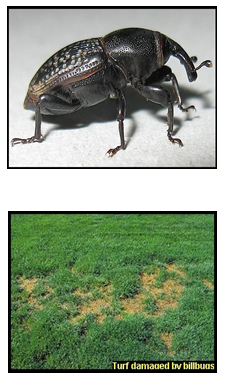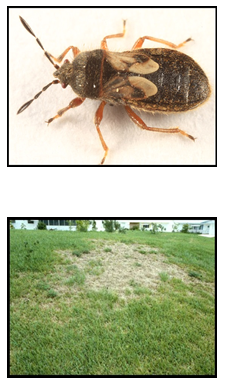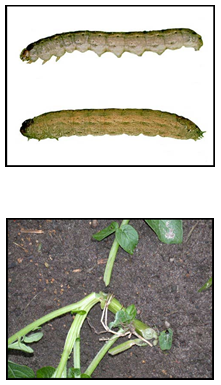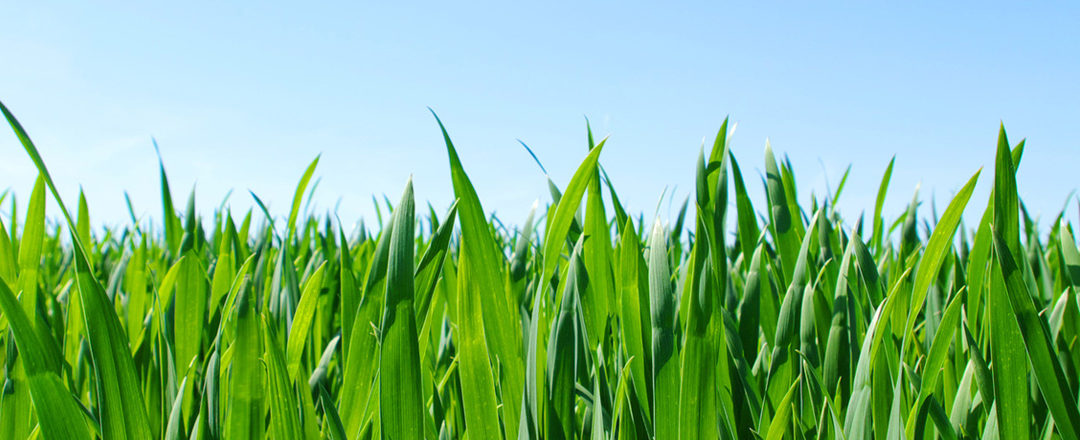Surface feeding insects are exactly as the name states and they can damage your lawn. They are a group of several insects that feed at or just below the surface level of the turf and cause damage to the shoot of the grass. These insects deal their damage at night and go back into hiding during the day. In most cases small infestations are not a problem, however if left unchecked they can grow and cause serious damage to your lawn. Below is a list of the common surface feeding insects that you are likely to see in your lawn:
Bill Bugs
When Does Damage Occur: Damage appears in late-June through August.
What Does the Damage Look Like: Bluegrass billbugs pierce the grass with their mouths and feed on the inside of Kentucky bluegrass. Light infestations in lawns often produce small dead spots that look diseased. Billbug damaged turf turns a whitish-straw color rather than the yellow. If the stalks break easily at ground level and the stems are hollowed out or are full of packed sawdust-like material, billbugs are the culprit.
Control: With light to moderate billbug infestations, much of the damage can be masked with fertilization and daily irrigation. Insecticides may need to be applied.
Chinch Bugs
When Does Damage Occur: Damage appears when daytime temperatures reach 70 degrees F.
What Does the Damage Look Like: The chinch bug is only 1/8 of an inch long. They pierce the plant with its four-jointed beak and suck out the plant sap. Irregular patches of turf begin to turn yellow then straw colored. Dead patches appear in sunny areas and many times along a driveway, curb, and sidewalk. Damage resembles drought stress.
Control: Slightly damaged turf will recover rather quickly if lightly fertilized and watered daily. Insecticides can also be applied to areas with heavier damage.
Cutworms
When Does Damage Occur: They begin their life cycle in the fall and by the following summer, they emerge as moths.
What Does the Damage Look Like: Cutworms are named so because they cut plants right at the stem when feeding. Feeding can be sporadic where in some cases they eat the plant all the way down or they cut the plant and feed for a little bit, but then move on. This makes cutworm damage sometimes tough to decipher. Cutworms deal the most damage to newly seeded lawns as they catch the grass when it is in it’s infancy.
Control: Small amounts of cutworm damage can be outgrown with proper watering and nutrients. Larger problems need to be treated with an insecticide.
Sod Webworms
When Does Damage Occur: Damage appears in late June into early August.
What Does the Damage Look Like: The larvae emerge from burrows in the ground to chew grass blades off just above the thatch line, usually at night. This causes general turf thinning or even irregular dead patches in sunny, hot, and dry areas. The thin turf allows weeds to establish in the lawn making it unsightly. In thick, green turf, injury appears as small brown patches about the size of a quarter to three inches in di-ameter. The adult is the white moth that flutters above the ground.
Control: Damage can sometimes be outgrown if watered daily. Insecticides may need to be applied.


